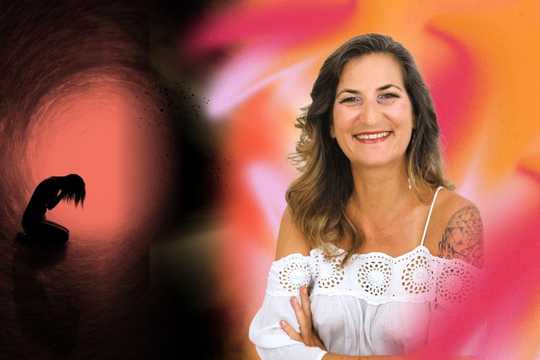Art therapy and psychedelics can form key pillars along the path of integration and healing. Join Charmaine Husum, DKATI, RTC, CT as we learn about the importance of trauma-informed practice, integration, and creativity.
Getting to Know Charmaine, Art Therapy and Psychedelics
As a Certified Art Therapist and Registered Therapeutic Counsellor, Charmaine Husum DKATI, RTC, CT supports people in finding personalized routes to emotional healing with a focus on inner resources and transpersonal connections to spirit. With years of experience and training in the area of psychedelics, she helps people, both in groups and individually, understand and integrate the details of their psychedelic experiences using trauma informed art therapy, counselling, meditation, and tapping into the innate wisdom of the body through various somatic approaches.
Her current research enthusiasms are in neuroplasticity, neuroscience, epigenetics, mystical/ psychedelic integration and intergenerational trauma. She meets with clients from around the world online, in person at Centre of the HeArt on the traditional territories of the Blackfoot Confederacy (Siksika, Kainai, Piikani), the Tsuut’ina, the Îyâxe Nakoda Nations, and the Métis people of Calgary Alberta, Canada and at retreats held internationally. Charmaine connects art therapy and psychedelics together in a healing, integration-focused space in her practice.
The Importance of Integration
A key focus of Charmaine’s work, which straddles art therapy and psychedelics, is focused on integration. Integration plays “a key role in healing. I am an integration specialist, an art therapist, and a somatic practitioner. One of the key reasons I find that integration is important when using psychedelics is because there needs to be a container to hold the space and the experience.
When we look at the history of psychedelics and especially plant medicines in Indigenous cultures, they already have that container and that community. These medicines are well-known to people before they use them. They can connect with loved ones afterwards to explore their experience and to learn more from it.”
“However in Western cultures, after we fly down to South America to partake in a ceremony end up coming back to our home, there may have been a small integration circle afterwards, but the effects of the medicine can sometimes wear off and that creates the need to go back for more. Or what can sometimes happen is that we’ve had such an awakening that when we come back home, we just need to change everything in life, which can sometimes be very disruptive.
Follow your Curiosity
Sign up to receive our free psychedelic courses, 45 page eBook, and special offers delivered to your inbox.I believe the psychedelic experience is not necessarily a cure to what’s happening when someone is seeking out psychedelics for medicinal healing, but rather an opening for deeper awareness, for deeper understanding and for deeper healing to take place.”
“Connecting to the memory of the experience and the spirit of the medicine as a resource can help us to grow and continue the healing as we move through life. That being said, not all psychedelic experiences are pleasant. In fact, when we’re working with some of the more intense psychedelics, say like iboga or ayahuasca, it can be very dysregulating. Integration can be extremely important to make sense of what happens. I believe that a door opens to healing, and that’s when we start to do the work through the integration.”
“Another important reason for integration is that some people might use psychedelics for healing. It’s one thing to use psychedelics expand consciousness, but it’s entirely different if one is using psychedelics for psychological healing. So oftentimes, people have experienced trauma in their lives and that brings them to the point of wanting change. Psychedelics may be a last resort. Going through a session, whether that in ceremony or in a doctor’s office, it’s just the beginning. It’s just kind of ripping the band aid off and then the work [of integration] gets it done.”
Holistic Integration
“In my practice, above all, what’s most important to me in my approach is to be trauma informed, [especially when we’re talking about art therapy and psychedelics]. It’s a common buzzword these days, trauma-informed, but it’s very specific in its meaning. It requires training to fully understand and be able to hold a trauma informed space. In my opinion, sometimes being trauma informed can be misunderstood, that one must experience a severe trauma to have trauma, but really when we’re working with people, we really don’t know, especially if we’re working with large groups.
Also, we now have current research into the brain and neuroplasticity and epigenetics. Trauma affects everyone differently and different traumas affect people differently. So, what may seem like something minor could be a huge trigger. What trauma-informed means for me is a way of holding space. It can be a way of speaking to people, even the words that are used can be triggering.
So, what we’re working to do is hold a space that feels safe and comfortable, where people are not triggered. Sometimes being in a room of 50 people, all experiencing an altered state of consciousness, whether that be through psychedelics or breath work or whatever, even a yoga class can be triggering and retraumatizing.”
“Another way that I approach integration is client centered or person centered. What this means is that I follow the client’s lead in what they need. In working as a trauma-informed art therapist and counselor, I believe that true healing lives within everybody, that they can access that in themselves, and I am only here as a guide. I also work transpersonally.
And again, it depends on who I’m working with. If I’m working with someone who’s an atheist, then we’re probably not going to speak about spirits or the spirit of medicine still being with them, but I would approach it in a different way of what they feel connected to in the world. Working transpersonally with medicine, and with people in general, means working with their worldview.
So, I find it super supportive if someone believes in something larger than themselves and we incorporate that into the work we do. I work mainly with trauma, and people who’ve experienced trauma. So, first and foremost is finding safety. Sometimes an easy way to access that is to tap into something that’s larger than themselves, that they can feel as a resource and a support.”
“Another way that I approach integration in my practice is through psychoeducation. I am fascinated with neuroscience and neuroplasticity, how things are happening in the brain and changing in the brain – both when we’re using psychedelics, but also through meditation and through art making. I often explain to people how we’re re-routing neuropathways in the brain in the work we’re doing.
Ultimately, this is to increase the neurotransmitters in the brain, the neurochemicals in the brain, to deliver more serotonin and dopamine and oxytocin and all these good feelings. So, I believe that when people know what’s happening, that they feel a greater sense of control. And because I work in the areas of PTSD and complex PTSD and trauma, what’s often happened is control has been taken away from someone.
So, it’s in sessions that we work to find control in whatever way that looks. Often, that is finding inner control and by knowing what’s actually happening in our brains – it helps people to make sense of the processes that are going on.”
Harm Reduction, Art Therapy and Psychedelics
“Harm reduction is a key part of ensuring that healing can occur, especially when talking about vulnerable states like in art therapy and psychedelics. “Harm reduction can sometimes be overlooked when we’re speaking about psychedelics and using psychedelics, because ultimately psychedelics are seen as non-addictive. The more we take them, they just become less potent.
So, although they’re seen as less addictive, what’s addictive is seeking out heightened experiences. And that is definitely something I’ve seen quite a bit myself and from other colleagues and psychologists and counselors that I work with, is people returning to the medicine over and over again, to get back to that feeling of connection and healing.
That’s actually the reason why I got into integration work in the first place, noticing this need, speaking to people who said they were on their hundredth ceremony, for ayahuasca, or using mushrooms every weekend or acid.”
“And if it’s someone’s choice to expand their consciousness, that’s great, that’s their choice. But when we’re speaking of using psychedelics for medicinal purpose, and especially for psychological healing, I feel it’s important to create a container and a space and an understanding where we use the psychedelics for healing, with a harm reduction lens.
We use it to open something up and then we do our personal work, because we can’t keep going back and going back because it creates that desire for heightened experiences, which may be psychedelics at first, but it can also transition into other areas of life or other things in life where we’re seeking excitement in ways that can become dangerous as well.”
“Ultimately, we’re working to integrate the medicine into the person for full actualization of that healing, that capacity of self for resiliency and moving from a place of survival into a place of thriving. I have created an online program for this, where I work with people using these three stages of trauma therapy, which was first outlined by Judith Herman in 1992. Bessel Van Der Kolk uses this quite a bit too.
We’re working through three different stages. So, we’re creating safety to begin with. Then, we may be tapping into an experience of trauma. It’s never that the trauma needs to be spoken about, or even the experience of the medicine needs to be spoken about, but what the effects were or what the symptoms are. And then finally, we move into connecting with our community, our friends, and allowing more human connection. Harm reduction is about creating this lasting healing to take hold within the body.”
“I’m not a doctor, I do integration and support for those working through their experiences, but I do find it’s important to know if someone’s been using any other medications. The contraindications with some medicines can be deadly.
It’s really important when we’re speaking about harm reduction to know what kind of medications are being used…I’m not sure what [legalization and treatment] look like, but I am seeing more and more of these medicines being used in a way that creates a business and makes money, where people aren’t the focus.
I think that’s quite different from what Indigenous tribes initially used these medicines as. It’s important that practitioners of all types are well trained, that there’s regulation and credentials with who is holding these spaces for healing, and that they can also support harm reduction.
Creativity, Art Therapy and Psychedelics
Art therapy and psychedelics share many commonalities, but one vital one is creativity. “Creativity is big part of the work I do as an art therapist. When we think of making art, a lot of people think, oh yeah, it feels nice to make art. And it’s true. Art is therapeutic, which would be different from art therapy.
The way I work with people in session is often that we’ll start out spontaneously. It’s easy for us to move into our head and think about what we’re creating. I use a somatic approach and meditation and mindfulness in my practice as well. So, I will guide people through a meditation to tap into sensations in the body.”
“We’re allowing the unconscious to speak. One of the reasons we use art in therapy is because it allows the process of healing and expression to evolve from an unconscious place. Oftentimes we don’t know what’s going on. We might feel like something’s going on in my life, I’m feeling this way, everything’s crashing in, I don’t know why.
When we’re using the art and coming from a mindful place, allowing someone to just look at all the materials in front of them, grabbing whatever material stands out, and begin moving the material on the paper. I’m always very clear that we’re not making beautiful art, we’re expressing our feelings and oftentimes, they’re not that beautiful.
I invite people to just create whatever comes out. Just taking a moment as they create to become very mindfully aware of the sound of the material, of the feelings, of any memories or sensations or thoughts that are coming up as they’re creating.”
“Once they feel that they’re finished, we process the art. We will discuss what is being seen. We’re not interpreting the art. I invite the client to reflect on thoughts, feelings, what do they see specifically. If there’s a red box, not explaining to me what a red box means, but just, what is it? It’s a red box.
And then from there, I’ll move someone into maybe associations and metaphors connected to different parts of the art, which can help open up an exploration of things that may not have been spoken about or may not have even been known about. But, it also creates extra safety.
If someone is just telling you what’s happening, there’s an intensity to it, but when we can move those feelings onto paper in front of us, and now speak about what’s in front of us, rather than what’s inside of us, it creates not only a different vantage points, but a different understanding and some distance too.”
“Sometimes what I’ll do is I’ll invite them to change the art. Maybe the art needs something else. We may if there’s any messages within the art, after we process to see what else is there. And then always, what’s also just as important is what do we do with the art afterwards.
In my practice here, if I’m working with people in my studio, I always have a folder for them where they can store their art here. Or people are welcome to take their art home. Or when I’m working online with people, I remind them to put the art in a place that feels safe and contained.
If it’s something that’s very activating, we don’t want that just laying around the house. Or if it’s something really resourceful, we might want to put it on the wall. I do believe that it’s the unconscious coming forward, and we’re tapping into this power – it knows what needs to come forward. So, I invite people to trust the process, follow the process, and know that inner knowing, that intuitive place, that place where our soul lives, is guiding this process, and that they’re safe and contained.”
“Another art therapy practice I use is sacred geometry. Just observing, understanding the way that sacred geometry lives in our world, how it is all around us, how we are geometric beings – our DNA, our cells. Our Earth is a circle.
We are within the circle and our Earth is within the solar system, which is a circle, right? There’s all these circles and fractions and equations that are all around us that I find really give a lot of grounding to the work I do with people. What’s happening to the brain when we’re making sacred geometry is we are utilizing both the left and right hemisphere of the brain, activating the corpus colostrum to integrate both hemispheres.
I’ve been working as an artist for 25 years. When I’m working with these images, something happens in my body, and I feel it in my brain. I feel my parasympathetic nervous system engage, a deep relaxation, and a deep connection to the world outside of me.”
“I might not use sacred geometry with everybody in session, because it can bring up some frustrations if it doesn’t look exactly the way we want it. That is not what art therapy is, it’s not about beautiful art, but what it does is open up this capacity for self-acceptance.
I teach different workshops on different sacred geometry lessons, and one of them is the flower of life. And so just to notice how one circle off a little bit will change the entire structure of everything. But then, how afterwards we can go over it with a pencil or a marker or color it in and how we can kind of adapt something that may have felt imperfect and see the perfection within it.”
Art therapy and psychedelics are two of the methods Charmaine leans on to help promote healing through integration.
Yoga & Meditation
“I’m also a yoga teacher and meditation teacher [and lean on those modalities]. I usually bring meditation and mindfulness into sessions, like sound healing. So, different chimes and crystal bowls. It’s allowing someone to recognize what’s happening in the body, to really tap into those subtle body sensations that happen when we connect with our breath and slow down and connect to the space around us.
Sometimes the workshops I’ll do are a mixture of Kundalini yoga and other types of yoga – I’m trained as a Kundalini yoga teacher but find all different yoga modalities and meditations to be supportive for people.”
“Then, I use somatic experiences. I was trained in integrative body psychotherapy. I believe that trauma does live in the body, but so does well being. Tapping into these feelings and sensations as we’re developing that relationship to where things live, and then also creating a visual representation of what it is – what we’re doing is we’re creating a path to help access it when we need to.
When we’re feeling our mental health go offline, when we’re needing that extra support, sometimes the last thing that one can remember is, how do I come back? How do I access well being? By doing these activities and experiencing these pieces in session, we’re creating a pathway that’s worn a little deeper each time we do it so that it can become something automatic that happens to help support people.”
“Another practice I use is dream work and journaling, especially within my psychedelic integration program. Journaling and dream work are super important to understand and access more information from our psychedelic experiences.
Just by paying attention to my dreams and writing them, there’s so much healing that can be accessed and wisdom and information that’s also coming from within us. We spend a lot of time in our lives sleeping.
If we’re able to utilize that space in a way that we just begin paying attention to what our dreams are, maybe we do move into a place where we are able to control pieces within our dreams, or just make art about the dreams afterwards to explore different messages.”
Connect with Charmaine
If you’re interested in art therapy and psychedelics and fully working through integration, reach out to Charmaine. “You can reach out by accessing my website. There, you can read a little bit more about me, and you can also book a session. There are some great resources and there’s also a link to my psychedelic integration program, which is a nine module program, self-paced, that incorporates sacred geometry, dream work, journaling, neuroscience, yoga, and art therapy. If anyone was interested in looking at some sacred geometry art too, you can also see some of my work on Etsy at Charmaine Husum Art.”









